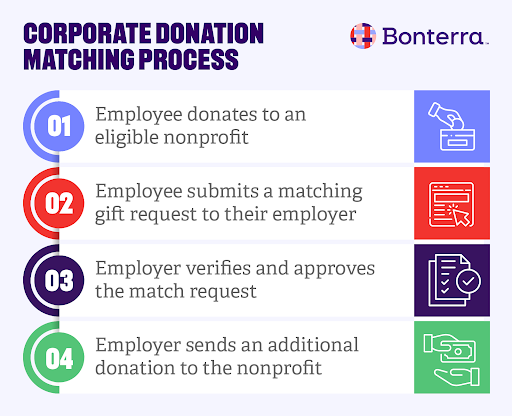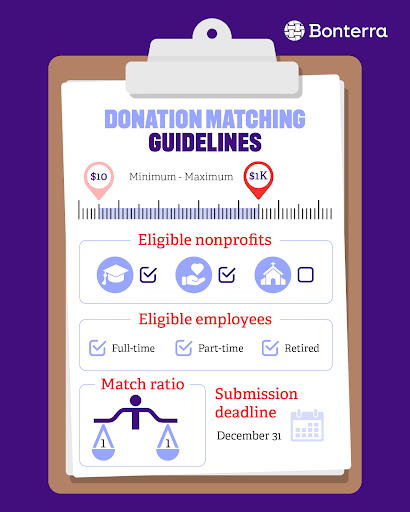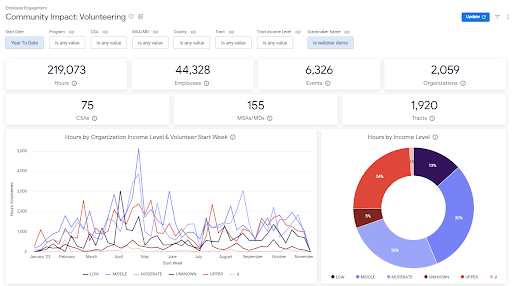With 65% of Fortune 500 companies and 51% of Russell 1000 companies offering donation matching programs, it’s clear that this type of corporate social responsibility (CSR) program is here to stay. Corporations everywhere have seen the benefits firsthand and continue to prioritize driving impact by matching their employees’ donations to worthwhile causes.
If you’re not already familiar with the basics and benefits of corporate donation matching, this guide will get you up to speed. We’ll cover everything you need to know about donation matching, including how to start your own program inspired by successful, real-life examples.
What is donation matching?
Donation matching is a type of corporate philanthropy program in which companies financially match their employees’ donations to nonprofit organizations, typically at a 1:1 ratio. Also known as matching gifts, donation matching is one of the most common and impactful forms of corporate philanthropy.
It’s more than a CSR program — donation matching is a strategic philanthropy initiative that drives real change. Since donation matching involves both employees and corporations giving to worthwhile causes, it generates a clear, measurable impact while empowering team members to get more involved in philanthropy.
How do matching donations work?
Donation matching programs are an employee-led corporate philanthropy strategy, meaning that your employees always take the first step. They get to choose which nonprofits to give to (within your company’s restrictions), how much to give, and when they participate. Once an employee decides to give, the entire donation matching process works like this:

1. An employee donates to an eligible nonprofit: Your employee makes a regular donation on a nonprofit’s donation page and checks if it’s eligible for corporate matching.
2. The employee submits a matching gift request to their employer: Depending on the CSR software you use, employees may be able to submit requests from your company portal, a donor portal within your CSR platform, or directly on nonprofits’ donation pages.
3. The employer verifies and approves the match request: When you receive the request, your company checks that the donation meets all of the program’s requirements, such as gift size, organization type, and kind of donation.
4. The company sends an additional donation to the nonprofit: Once verified, you’ll follow your company’s donation matching guidelines to send the appropriate amount directly to the nonprofit.
At the end of the process, the nonprofit your employee supports receives two gifts that it can use to pursue its purpose.
This is the traditional way to match donations, but companies can also explore other types of donation matching based on their needs and employees’ preferences. Donation matching programs can also automate matches for gifts made directly into a system, to make things easier for the employee so that match dollars aren’t left on the table and can maximize your overall impact.
In addition to a traditional program, you might offer company-wide donation match challenges, custom matching gift pledges for specific nonprofits, or fundraising matches where your business matches donations raised by your employees through peer-to-peer fundraisers. Bonterra’s Fundraising and Engagement software offers a more optimized solution through our Dollars for Doers program — where company funds are used to match employees’ donation of service hours. Each program works similarly but includes additional restrictions, like a set time frame, maximum amount donated, or organization.
Donation matching benefits for companies
Donation matching programs are popular with companies across the country for a reason. Effective matching gift programs offer several benefits for your business, including:
- Increased social impact: Unlike traditional CSR programs such as ESG initiatives that focus inward and don’t produce measurable results, donation matching helps your company generate real impact. By donating funds to vetted nonprofits and encouraging your employees to do the same, your company multiplies the impact social good organizations can create.
- More engaged employees: Your employees want to work for a company that prioritizes social good, but they also want to participate directly. Donation matching allows employees to take the lead, empowering them to direct corporate funds to the causes they care about most.
- Improved employee retention: Double the Donation reports that “58% of companies surveyed said workplace giving programs are somewhat or very important in retaining talent.” When your employees are engaged in philanthropy and believe in your company’s commitment to social good, they’re more likely to stay long-term
- Reputation boosts: Publishing impact reports and promoting your commitment to social responsibility can improve public perception of your company. Customers and clients want to buy from socially responsible companies, and a successful donation matching program proves your business’ social impact.
- Potential for long-term partnerships: Donation matching programs can introduce your company to hundreds of organizations, opening the door for mutually beneficial partnerships down the road. Once you find a nonprofit that aligns with your company’s values, you might support them with a sponsorship, grant, or custom-matching gift program.
Along with offering these benefits for your company, donation matching benefits nonprofits, their beneficiaries, and your employees. Nonprofits get necessary funding while your employees get to increase their personal impact and deepen relationships with the organizations they care about.
How to start a corporate donation matching program
Launching a donation matching program at your company is an exciting endeavor, but it requires making a few key decisions first. Follow these steps to build a solid foundation for your donation matching program.
Set donation matching guidelines.
Start by determining what kind of organizations and employees you want to include in your program, along with how much money your company is willing to allocate to donation matching. Your company’s leadership team should discuss your options and decide how to set the following key program guidelines:

- Eligible organizations: Will your company match donations to any 501(c)(3) or only certain types? Think about different kinds of nonprofits, educational institutions, and religious organizations that you want to support with corporate funds.
- Eligible employees: Which employees will get to participate in your program? Some companies allow only full-time employees to request matching gifts, while others include part-time and retired team members.
- Match ratio: Will you match gifts at a 1:1, 2:1, or .5:1 ratio? A 1:1 ratio means you’ll match gifts dollar for dollar, turning a $50 employee donation into a total $100 contribution to the nonprofit of their choice.
- Submission deadlines: When should employees submit their donation matching requests? Most companies choose either the end of the calendar year or the end of the fiscal year.
Consider your company’s core values and industry focus as you decide what kind of organizations should be eligible for donation matching. For instance, if your business is a tech start-up that values education and innovation, you might match gifts to higher education institutions and scientific research associations in addition to nonprofits.
When it comes to making decisions about your match ratio, minimum, and maximum, take employees’ preferences into account along with your philanthropy budget. Higher maximums generally boost employee participation, with maximums over $10,000 increasing engagement with donation matching programs by up to 40%.
Outline the corporate matching request process.
After you solidify your program guidelines, determine how and where employees should request donation matches.
Some small companies manage the request process manually, such as by having employees fill out a paper form or email their matching gift requests to a specific person at the company. However, you can reduce the administrative burden and boost employee engagement by using CSR software instead. These solutions provide employees with a streamlined request process and help program administrators track, verify, and approve match requests with ease.
Regardless of what solution or process you use, make sure to ask for important details about the donation. In their requests, employees should submit:
- The exact donation amount
- The name of the organization they donated to
- The date they made the gift
- Their donation receipt or the nonprofit’s contact information for verification
Most CSR software solutions will collect this information for you, making it easy to verify eligible donations without needing to ask employees for more details.
Launch and promote your donation matching program.
Next, get ready to launch your new giving program by creating documentation for employees. Outline all of the details, steps, and benefits of your donation matching program, including eligibility guidelines and information about the request process. House this information in a place where employees can easily access and refer back to it, such as your employee handbook or company portal.
Decide how you’ll announce the program and get employees excited to participate. For instance, you might send out a company-wide email and host a Q&A session, or you could announce it during a regular team meeting. Consider offering participation incentives to generate momentum, such as small prizes for the top participants.
Use corporate philanthropy software to track your company’s impact.
Finally, make sure you have a system in place to measure the success of your donation matching program. Define what success means for your company, whether that’s a certain amount of money donated or a percentage of participating employees.
Most importantly, you should track and report on the impact of matched donations. For instance, if you contributed $5,000 to a food bank, your impact report might say that you fed 3,000 families for a month.
Corporate philanthropy software can help you measure both your company’s social impact and employee engagement with the program by tracking every matched donation. Access robust reporting tools to quickly calculate and analyze metrics like total dollars matched, number of organizations donated to, and distribution of cause areas.
For instance, Bonterra Strategic Philanthropy includes 15 pre-built foundational reporting dashboards to help you track and visualize key program outcomes. However, the platform allows for endless opportunities to easily build more that are tailored to your organization. Report on both dollars donated and employee hours volunteered for a holistic view of your company’s impact on community organizations.

Corporate matching examples from leading companies
As you craft your new donation matching program, take inspiration from leading matching gift companies and what they’re doing well. Each of the following businesses uses Bonterra Strategic Philanthropy to maximize their social impact, engage employees, and give more funds to worthwhile causes. Explore their stories to see what your company can do with corporate matching.
CVS Health
In 2022, CVS Health launched a special emergency response donation matching program to provide medical aid to Ukraine. The company created a dedicated Ukraine relief dashboard within Bonterra Strategic Philanthropy and called on employees to donate as soon as possible. Within 24 hours, CVS Health provided over $50,000 in matched donations, totaling $100,000 in total funding for the American Red Cross.
Shipt
Shipt, a same-day delivery service, offers a holistic workplace giving program that encourages employees to donate and volunteer often. With Bonterra Strategic Philanthropy in place to measure the program’s community impact, Shipt achieved the following results:

- Over 600,000 pounds of food donated
- One million meals provided
- $1.3 million donated to community organizations
- Six million community members served
These numbers are a great example of how companies can measure and communicate their social impact in tangible ways. Shipt goes beyond funds donated, giving employees and customers a better idea of where the funds went and who they helped.
Schneider Electric
Schneider Electric wanted to drive more employee engagement through a philanthropy program, so it launched corporate matching and volunteering programs with Bonterra Strategic Philanthropy’s help. In the end, this company donated over $19.5 million and boosted new hire participation by 10%.
Drive corporate impact with donation matching
Donation matching programs are a highly impactful way to generate more impact and engage employees at the same time. With the right mindset and best-in-class software on your side, your company can see results from your program in no time. Remember to continually evaluate your program and take employee feedback into account, and you’ll end up with a thriving donation matching program.
Streamline donation matching and drive more impact with Bonterra Strategic Philanthropy.




